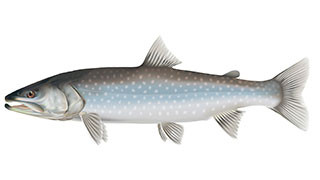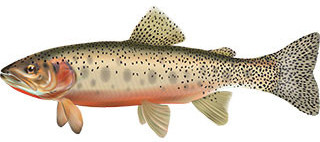Government mail service may be affected by the Canada Post labour disruption. Learn about how critical government mail will be handled.
Overview
Native trout have made the eastern slopes of Alberta their home for thousands of years, but are now experiencing severe declines in population size and distribution. These species require cold, clean, clear and connected water to survive and are challenged by habitat degradation, fishing pressure and hybridization or competition with non-native species.
Introducing Alberta’s native trout
Athabasca rainbow trout are found in the upper reaches of the Athabasca watershed. Healthy populations remain in isolated creeks but no longer exist within an entire watershed. Athabasca rainbow trout are classified as Threatened under Alberta’s Wildlife Act and Endangered under the federal Species at Risk Act.
Figure 1. Athabasca rainbow trout

Bull trout, Alberta’s provincial fish, are only found in the upper reaches of rivers originating in the eastern slopes. Despite nearly 2 decades of harvest protection, healthy or recovered populations are found primarily in protected landscapes such as national and provincial parks. Bull trout are classified as Threatened under Alberta’s Wildlife Act. Under the federal Species at Risk Act, the Saskatchewan-Nelson River populations are listed as Threatened, and the Western Arctic populations are listed as Special Concern.
Figure 2. Bull trout

Westslope cutthroat trout are found in the upper reaches of streams within the Bow and Oldman River watersheds. Small populations only remain in isolated pockets of a watershed (not throughout an entire watershed). Westslope cutthroat trout are classified as Threatened under Alberta’s Wildlife Act and Threatened under the federal Species at Risk Act.
Figure 3. Westlope cutthroat trout

Native trout population density on a provincial scale is determined by using the Fish Sustainability Index (FSI). To learn more about FSI for native trout species, visit Fish Sustainability Index.
Recovery initiatives
Coordinated initiatives to support native trout recovery are led by Environment and Protected Areas and supported by many partner organizations. The Government of Alberta is focused on ensuring progress is made towards recovering these species by addressing key threats on the ground.
Recovery plans
The requirement for a provincial recovery plan is triggered when a species is listed as Threatened or Endangered under the Wildlife Act.
Native Trout Recovery Program
Alberta’s Native Trout Recovery Program (NTRP) is aimed at aligning the work of the Fish and Wildlife Stewardship Division, other Government of Alberta ministries and divisions, and program delivery partners to advance the recovery of native trout in the Eastern Slopes Fish Management Zone. The work of the NTRP is guided by provincial and federal recovery plans/strategies using a multi-species approach for the eastern slopes.
- For more details see: Native Trout Recovery Program.
Watercourse Crossing Program
The goal of the Watercourse Crossing Program (WCP) is to address threats to fish survival stemming from poorly constructed and maintained watercourse crossings that cause habitat fragmentation, erosion and sedimentation.
The Watercourse Crossing Remediation Initiative empowers various sectors, such as forestry and oil and gas, to self-inspect crossings on their property or within their leased land and remediate them in priority order where fish passage is impaired or impeded. Albertans can get involved by downloading the Alberta Watercourse Crossing Inventory App on their phone to report crossings that are not suitable for fish passage.
To review information specific to this program, see:
Habitat improvement and protection
Improving fish habitat is an important component of native trout recovery. In addition to habitat work being completed under the NTRP, the Government of Alberta has a number of habitat restoration and enhancement initiatives that are resulting in tangible fish habitat improvements. Historical programs include:
Whirling disease
Whirling disease affects salmonid fish including trout, salmon and whitefish. It was detected in Alberta in 2016. This disease, caused by a parasite which can affect nerves and cause cartilage damage, can cause high levels of mortality in some species of fish.
The severity of whirling disease depends largely on the age and size of the host, with young fish being the most vulnerable. Whirling disease has been detected in the Bow, North Saskatchewan, Oldman and Red Deer river watersheds in central and southern Alberta.
To review information specific to this program, see:
Legislative mandate
The guiding legislation for the NTRP includes: